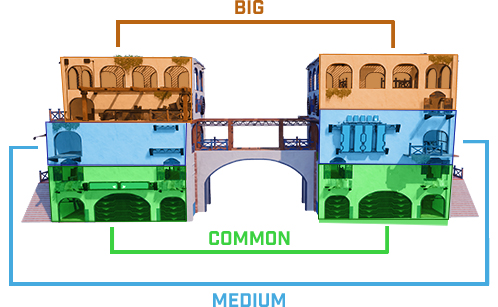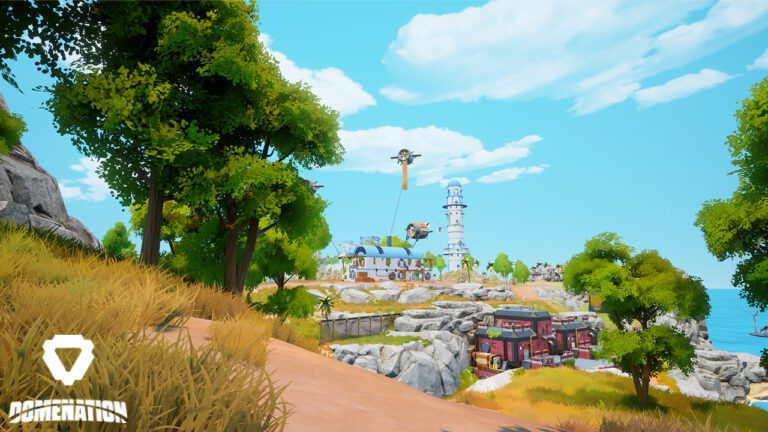Verticality is a core element in level design, even more so in multiplayer shooters because of the advantage it can provide to one player over another. In battle royale games, its use varies radically depending on the characteristic mechanics of each one that vary the way they are played.
Fortnite, for example, uses verticality a lot, as it gives players the possibility to build different elements that serve both as a way to position themselves above their competitors and to take cover in case they find themselves at a height disadvantage. Apex Legends or Call of Duty Warzone, on the other hand, are more cautious when it comes to providing great verticality to their levels because they give players fewer tools to gain height or compensate for the disadvantage of being below their opponents.
In Domenation, the player has a wide range of skills that increase his mobility. Being a key element in the gameplay, we wanted to design the rest of the mechanics and the map around it.
Domenation’s character differs from those in other games of the same genre because of the numerous options it gives the player when it comes to moving around the map. In addition to running and jumping, the player can dash in the direction of movement, perform a second jump in the air and slide; all of these abilities are regulated by a stamina bar.
Its level design, through verticality, seeks to enhance these skills, seeking to provide the player with a sense of fluidity and freedom when traversing the map. This is achieved, for example, by joining tall buildings with downward slopes (looking for a leap of faith combined with sliding) or by encouraging the player to move on top of the different buildings, creating new paths on the map.

Unlike other games of the battle royale genre, Domenation’s chests (through which the player obtains items and weapons) have different tiers or rarities. There are three of them, marked by their color:
To encourage the player to explore the buildings and the different areas of the map, while also utilizing the mobility skills, we have tried to balance the rarity of the chests based on verticality; that is, we try to ensure that within an environment or a structure it is more likely to find rarer chests the higher it is located. By doing so, the player will have to make an effort and squeeze the resources given to him to get the best possible loot.

Other characteristic elements of Domenation are the Camps: PvE zones where the player receives loot in exchange for defeating the creatures (called Rovers) that inhabit the zone. This loot varies in quantity and rarity depending on the amount of Rovers that the camp contains. There are also different types of Rovers, both ranged and melee.
As with the other elements, Rovers are scattered throughout the structures near the camp, in different places and heights to encourage the player to scour the environment in order to find and defeat them all. In addition, with the Camps it is sought that the enemies that attack from a distance are located in higher and more difficult to access areas, forcing the player to clear the platforming of the area dodging their shots to reach them and be able to eliminate them, while the melee Rovers try to prevent this task from being easy.
Among the multiple benefits that verticality brings to the level design, there is the inclusion of landmarks – that is, points of interest that stand out in their environment and that are visible from a distance. These points are used both to differentiate an area from the rest ( to the point of giving its name to an area), and to guide the players on the map so they can easily know where they are and where the different main areas of the map are located.
In Domenation, we try to capitalize on this quality. Therefore, every main area has a landmark that lets the player know where he is and where he is going regardless of his position on the map. The Docks area, for example, has a large lighthouse that can be seen from almost anywhere in the southern part of the map; or Nexus City has the Nexus, a large floating structure, at its center.
Thanks to these landmarks, Domenation’s navigation becomes faster and easier, while creating unique, different and emblematic areas within the map.

As explained, verticality is a key element in the design of a game of these characteristics, and it can bring many interesting and useful nuances to our map. However, if it is not used properly, it can lead to situations that worsen the final experience of the player.
The most obvious of these situations is the advantage that can be obtained by a player who is in a higher position than another. This is a problem in any multiplayer shooter, but it can be mitigated by different approaches. In our case, we have tried to make the vast majority of advantage positions to be buildings or structures with interiors to hide in case of being besieged from above as well as with numerous entrances to be able to access them from almost any side. In addition, we include covers in the areas that we consider most disadvantageous, and we have objects that can help the player get out of these complicated situations, such as smoke grenades that can hide him while he flees from the area.
As it happens with buildings, the terrain itself could become a problematic element when it comes to balancing the map. By having so much mobility, mountains that in another situation should not be accessible became surveillance posts from which to shoot enemies without exposing yourself and having the entire map under control. To combat this, we made it very clear which mountains can be climbed and which cannot, making this distinction visible. In this way, we distinguished between geographical features used as cover or to divide the terrain and those that are an active part of the players’ frequent routes, and elements around which to generate conflicts.
We were also concerned about the fact that by wanting to provide verticality to the level, players would stop playing at ground level. Therefore we designed the cities and areas of interest so that this does not happen, strategically placing the buildings to not encourage this behavior and generating irregular terrain that gives rise to different heights within the lower level of the map itself, making these areas interesting and fun for the player.